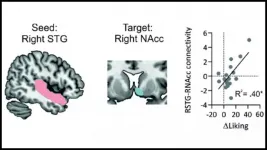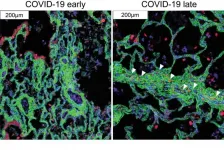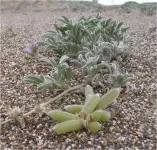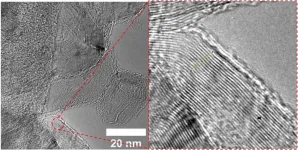Why the brain enjoys music
Interaction between auditory and reward brain circuits underpins musical pleasure
2021-03-29
(Press-News.org) Communication between the brain's auditory and reward circuits is the reason why humans find music rewarding, according to new research published in JNeurosci.
Despite no obvious biological benefits, humans love music. Neuroimaging studies highlight similarities between how the brain's reward circuits process music and other rewards like food, money, and alcohol. Yet neuroimaging studies are correlational by nature. In a new study, Mas-Herrero et al. sought to nail down the causal role of this circuitry by using non-invasive brain stimulation.
A group of pop music fans listened to a set of pop songs while the research team measured their brain activity with fMRI. Before the scan, the team indirectly excited or inhibited the brain's reward circuit with transcranial magnetic stimulation. Exciting the reward circuit prior to hearing music increased the pleasure participants felt when listening to the songs, while inhibiting it decreased pleasure. These induced pleasure changes were linked to changes in activity in the nucleus accumbens, a key region of the reward circuit. The participants with the greatest difference in pleasure also showed the greatest difference in synchronized activity between auditory and reward regions. These results indicate interactions between auditory and reward regions drive the pleasure we feel when listening to music.
INFORMATION:
Paper title: Unraveling the Temporal Dynamics of Reward Signals in Music-Induced Pleasure with TMS
About JNeurosci
JNeurosci, the Society for Neuroscience's first journal, was launched in 1981 as a means to communicate the findings of the highest quality neuroscience research to the growing field. Today, the journal remains committed to publishing cutting-edge neuroscience that will have an immediate and lasting scientific impact, while responding to authors' changing publishing needs, representing breadth of the field and diversity in authorship.
About The Society for Neuroscience
The Society for Neuroscience is the world's largest organization of scientists and physicians devoted to understanding the brain and nervous system. The nonprofit organization, founded in 1969, now has nearly 37,000 members in more than 90 countries and over 130 chapters worldwide.
[Attachments] See images for this press release:

ELSE PRESS RELEASES FROM THIS DATE:
2021-03-29
A team led by investigators at Weill Cornell Medicine and NewYork-Presbyterian has used advanced technology and analytics to map, at single-cell resolution, the cellular landscape of diseased lung tissue in severe COVID-19 and other infectious lung diseases.
In the study, published online March 29 in Nature, the researchers imaged autopsied lung tissue in a way that simultaneously highlighted dozens of molecular markers on cells. Analyzing these data using novel analytical tools revealed new insights into the causes of damage in these lung illnesses and a rich data resource for further research.
"COVID-19 is a complex disease, and we still don't understand exactly what it does to a lot of organs, but with this study we were able to develop ...
2021-03-29
Researchers at the Federal University of São Carlos (UFSCar) in the state of São Paulo, Brazil, have developed a novel far red light-emitting luciferin-luciferase system that is more efficient than those available commercially. An article on the subject is published in the International Journal of Molecular Sciences.
The study was supported by São Paulo Research Foundation - FAPESP via the Thematic Project "Arthropod bioluminescence: biological diversity in Brazilian biomes, biochemical origin, structural/functional evolution of luciferases, molecular differentiation of lanterns, biotechnological, environmental and educational applications", for which the principal ...
2021-03-29
ANN ARBOR--In a two-year study that could help guide educators developing the post-pandemic new normal, student groups at the University of Michigan assigned to make video presentations showed more creativity and risk-taking than groups making conventional in-person presentations.
"Given the importance of project-based learning, our study provides a way to turn virtual limitations into an advantage," said Fei Wen, U-M associate professor of chemical engineering. "We can enhance the student experience and learning outcomes."
Higher education, along with society at large, anticipates a shift in the balance between ...
2021-03-29
More physicians and pharmacists are advocating for patients to be made aware of animal byproducts contained in common medications, according to new research in the Journal of Osteopathic Medicine. Common medications, including widely used blood thinners and hormones, are often derived from animal byproducts and prescribed without consulting the patient about their beliefs.
"Patients deserve to know what their medications are made of, yet this information is rarely shared," said Sara Reed, student doctor at Lincoln Memorial University (LMU) DeBusk ...
2021-03-29
Climate change is altering the world we share with all living things. But it's surprisingly difficult to single out climate change as an extinction threat for any one particular species protected under the Endangered Species Act.
To date, the U.S. Fish and Wildlife Service has only formally considered impacts from climate change in listing actions for four animal species and one alpine tree.
But the effects of climate change extend to temperate climates as well. A new analysis of population data published in the journal Ecosphere shows that climate change represents a specific extinction threat for an endangered coastal lupine plant.
Biologists including Eleanor Pardini at Washington University in St. Louis have tracked all of the known stands ...
2021-03-29
HOUSTON - (March 29, 2021) - This could be where the rubber truly hits the road.
Rice University scientists have optimized a process to convert waste from rubber tires into graphene that can, in turn, be used to strengthen concrete.
The environmental benefits of adding graphene to concrete are clear, chemist James Tour said.
"Concrete is the most-produced material in the world, and simply making it produces as much as 9% of the world's carbon dioxide emissions," Tour said. "If we can use less concrete in our roads, buildings and bridges, we can eliminate some of the emissions at the very start."
Recycled tire waste is already used as a component of Portland cement, but graphene has been proven to strengthen cementitious materials, ...
2021-03-29
SUVA, Fiji (March 29, 2021) - A new study published in the journal Environmental Science and Policy addresses the impacts of COVID-19 and Cyclone Harold on Indo-Fijians engaged in small scale fisheries.
The paper says that countries, including Fiji, need to address ethical and social justice considerations and the politics of recovery efforts by putting vulnerable and marginalized groups front and center in the aftermath of pandemics and natural disasters.
What countries cannot afford is for economic recovery efforts to put additional burdens and risk on those invested in the SSF sector, and cause further widening of inequities, and increase ...
2021-03-29
A new study out of the University of Chicago and the University of Illinois Urbana-Champaign in humans, chimpanzees, rhesus macaques and baboons has found key differences in early gene expression in response to pathogen exposure, highlighting the importance of choosing the right animal model for the right questions. The study was published on March 26 in END ...
2021-03-29
A national survey of parents revealed that most parents who used ride-share services did so with their children, but only half of the respondents reported that children who were 8 years or younger traveled in the recommended child car seats or booster seats when in ride-share vehicles. Among parents of children in this age group, over 40 percent used only a seat belt for their child, while 10 percent allowed their child to travel on a lap or unrestrained. Overall, parents reported lower rates of child car seat use in ride-share compared with how their child usually travels. Findings were published in the journal Academic Pediatrics.
"Our results are concerning, as ...
2021-03-29
Barcelona researchers at the Hospital Clínic-IDIBAPS Research Institute, the University of Barcelona and the SOLTI academic cancer research group have shown that the molecular classification of breast cancer, which divides it into four subtypes (Luminal A, Luminal B, HER2-enriched and Basal-like) is useful for predicting the benefits of treatment in patients with advanced hormone-sensitive breast cancer. This is the largest study to have shown the value of the biomarker, and the first to do so in the context of a CDK4/6 inhibitor like ribociclib.
The study, published in the Journal of Clinical Oncology of the American Society of Clinical Oncology (ASCO), was coordinated by Professor Aleix Prat, head of the Medical Oncology ...
LAST 30 PRESS RELEASES:
[Press-News.org] Why the brain enjoys music
Interaction between auditory and reward brain circuits underpins musical pleasure





